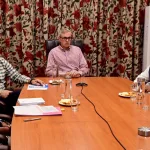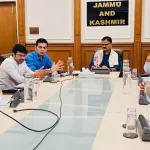Srinagar, Sep 01: Despite the improvements in the health sector, Kashmir still lacks a special trauma hospital that could provide treatment to patients under one roof, while the existing centres face a manpower crunch leaving the patients to suffer.
A few years back, the health department designated trauma hospitals at Gund Ganderbal, Pattan, Lawaypora, Rafiabad, Anantnag and Qazigund. However, these trauma centres are on paper only.
Even after 18 years, the Jammu and Kashmir Health Department is yet to operationalise trauma care at Trauma Hospital Lawaypora on Srinagar-Baramulla Highway. The department has only made operational a dispensary in the facility.
The residents of Lawaypora and its adjoining areas said when the hospital was sanctioned they had high hopes that it would help manage road traffic injuries on the highway.
“It was meant for trauma care but it is a dispensary. Ours is a huge area and road traffic accidents are often reported and injured are shifted to Srinagar hospitals like SKIMS Soura and SMHS Hospital,” said Irshad Ahmad, a local resident, adding, “Practically they have not done anything for the trauma care.”
Another such facility is the Trauma Unit Gund, Ganderbal, situated on the Srinagar-Ladakh National Highway. It was previously a PHC and later upgraded to a trauma centre.
Riyaz Ahmad, a resident of Gund, said that the operation theatre at the facility which was installed more than a decade back is still dysfunctional highlighting the lackadaisical approach of the health department.
“Not a single emergency trauma case is handled at the hospital. The health department had also procured some machinery equipment which is gathering dust there,” he alleged.
Talking to Rising Kashmir, Chief Medical Officer, Ganderbal, Dr Afroza Shah they have taken up the matter of operation theatre with concerned authorities and expected that the theatre would be started from the next season.
A senior doctor posted at the hospital said the facility has faced neglect over the years and failed to treat injuries caused due to road traffic accidents in the district.
“Rural trauma care is just on papers. There are no facilities available. Patients are bearing the brunt. We are compelled to refer them to Srinagar hospitals,” said a doctor. Locals said the shortage of paramedical staff causes inconvenience to the patients.
Similarly, people in north Kashmir’s Pattan town lament over the improper facilities at the Trauma Hospital Pattan which is now a converted sub-district hospital. The hospital faces manpower and infrastructure issues due to which it is unable to deliver critical care services.
A doctor at the Pattan hospital said patients, especially those who meet accidents on the Srinagar-Muzzarabad Highway, die while they are shifted to Srinagar hospitals for treatment.
Mudasir Ahmad, a resident of Pattan, said it is a nightmare when road accidents happen on the highway and they often struggle to make way for ambulances in traffic jams in the town.
“Due to lack of critical care treatment in entire north Kashmir, patients die on the way to Srinagar hospitals. This is very unfortunate,” he said.
A senior official of the health department wishing anonymity said the trauma hospitals were only designated and lack of proper planning is hitting the trauma care services in the valley.
“These are not trauma hospitals. These are felicitation centres or first aid centres. These have been wrongly designated as trauma hospitals,” he said.
Health officials also said that when the trauma cases are sifted to Srinagar’s tertiary care hospitals they often face problems as there is no designated trauma hospital in Kashmir under one roof and patients are often referred from one hospital to another hospital.
“Trauma hospitals along the National Highway-1 at every 20 kilometres are required with adequately trained staff and critical care ambulances,” the officials said.
However, the spokesperson of Directorate of Health Services Kashmir, Dr Mir Mushtaq said that trauma care is the priority of the government.
“We have established these trauma care hospitals and some have been upgraded. However, in certain places still, there might be some issues that are being looked into. It is the desire of the government that we should have full-fledged trauma facilities, particularly on the national highway and other places,” he said.
Mir said the hospitals situated on the national highway are always alert to manage any such cases or accidents. “We are monitoring it continuously and within some time there will be more improvement. We will try to make these trauma institutions functional in a proper way and for the best satisfaction of the public within the given resources,” he said.
Officials also informed that there are three categories of trauma hospitals: level-1, level-2 and level-3. SKIMS Srinagar, SMHS and Super Specialty hospitals come under the level-1 category. The trauma centres fall in level-3 hospitals and are meant for minor critical services.
A senior officer of the Health and Medical Education Department said trauma facilities need to be strengthened in terms of manpower as neurosurgeons, orthopaedics, anaesthetists are the backbone of a trauma hospital. He said there is a dearth of such specialists in J&K UT.
“Every effort is being made to engage such manpower. That is why the digital medium of tele medicine, tele-consultancy and teleradiology besides advanced ambulatory services are of paramount importance in dealing with trauma cases,” the officer said, adding, “The existing trauma centres shall also be strengthened in terms of necessary requirement, still the challenge remains on part of manpower to operate upon such equipment.”





